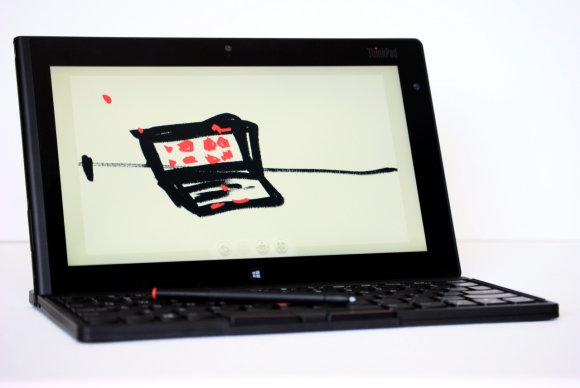Lenovo ThinkPad Tablet 2: Windows 8 Slate Review
The Optional Keyboard and Software
The Keyboard
The ThinkPad Tablet 2 by itself is clearly inspired by the design of its namesake laptops, but when you add the $120 keyboard dock, it suddenly transforms into a miniature ThinkPad laptop.
First, the great things about the keyboard dock. The six-row, island-style keyboard uses Lenovo's "smile" key shape, meaning the bottoms of each key are rounded to help you pick out the right ones. Its function row button includes actual functions--volume, mic mute, and screen brightness, as well as some Windows 8-specific shortcuts to Settings, the app switcher, and the All Apps list. The keyboard even has a red trackpoint, and the left, right, and scroll buttons that go with it. True, It's not a real trackpoint--it uses an optical sensor to track your finger movements, so you have to swipe with your finger rather than tilt it. The keyboard is netbook-sized, so it feels a little bit cramped, but I was able to type over 60wpm--just about as fast as I can on a ThinkPad X1 Carbon's full-sized keyboard.
The keyboard connects to the tablet via Bluetooth and has a micro-USB port so that you can recharge it when its battery runs out, using the same charger and cable you use for the tablet. In all my testing, I only had to recharge it once---and I hadn't topped it off when I took it out of the box.
Here's the problem with the otherwise excellent keyboard: it's just a keyboard. It doesn't actually attach to the screen--it just has a slot the screen docks into. So there’s no extra battery life, no physical connection, and certainly no hinge: there’s only one screen angle, and it's not ideal for working on a desk or on a lap. Even pressing too hard on the screen can knock the tablet off of the keyboard. If only the keyboard attached to the slate with a decent hinge--like that on the upcoming ThinkPad Helix--this would be a much better machine for work.
The stylus is pretty good, too. It should be since it uses Wacom digitizer technology. It's active, so you can see a little crosshair on the screen when the pen is within about a centimeter of the surface. When the screen detects the pen, it shuts off the capacitive digitizer, so you can rest your hand on the screen for sketching. The touch digitizer comes back on immediately once the pen is away, though, which can lead to weird hand detection errors if you lift the stylus up too high. If you can see the cursor/crosshair from the pen, it's detected. Otherwise it's not, and you can use touch. If you don't use a stylus for sketching, you're likely to only use it with Windows handwriting-recognition keyboard, which takes the place of the regular onscreen keyboard. My handwriting is resolutely awful but Windows was able to decipher it the vast majority of the time.
The tablet's integrated Intel SGX545 graphics are enough to easily do basic productivity tasks on its 1366x768 display, or a 1920x1080p external monitor connected via the mini-HDMI port. You can even use both at the same time, with caveats. Because the mini-HDMI port is on the bottom edge of the tablet, you can't rest it upright while the HDMI is connected, unless you spring for the $100 Lenovo desktop dock, which includes three USB 2.0 ports, HDMI, Ethernet, and a 65W AC adapter that charges the tablet faster than the one that comes with the tablet. So unless you spring for that dock or jimmy-rig your own solution, you can use the tablet display or an external, but not both at once.
The Software
The ThinkPad Tablet 2 runs 32-bit Windows 8 Pro, so it has access to both the Metro interface and the real desktop, not the stripped-down facsimile that comes with Windows RT. That means access to Photoshop, Office, weird Cisco VPN software--anything that runs on Windows. That said, with 64GB of flash storage (plus up to 64GB more via the microSD slot), an Atom processor, and 2GB of RAM, it's not going to replace a laptop or desktop for people who need serious computing power.
Lenovo bundles the ThinkPad Tablet 2 with a light dusting of bloatware. On the desktop side, Lenovo QuickLaunch simulates the Start button for those suffering from Windows 7 Separation Anxiety (it's a real thing), and there's a shortcut to the Intel AppUp Center, just in case you can't figure out how to find desktop apps elsewhere. The Metro side has more, with varying degrees of usefulness--Lenovo Settings offers quick access to power, location, camera, and audio settings, while Lenovo Companion has links to user guides, more settings, and a bunch of ads for other apps. QuickSnip lets you use the button on your stylus to take screenshots, then quickly edit them. The Tablet 2 also includes Norton Studio, Kindle, Skitch, Evernote, Accuweather, and Skype, most of which are genuinely useful, but all of which are easily obtainable from the Windows Store anyway.









